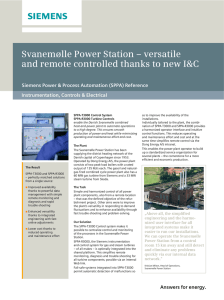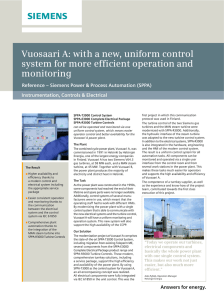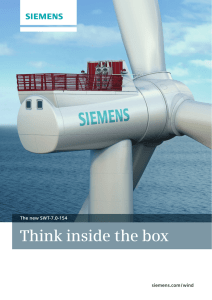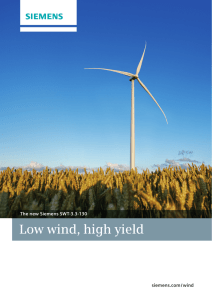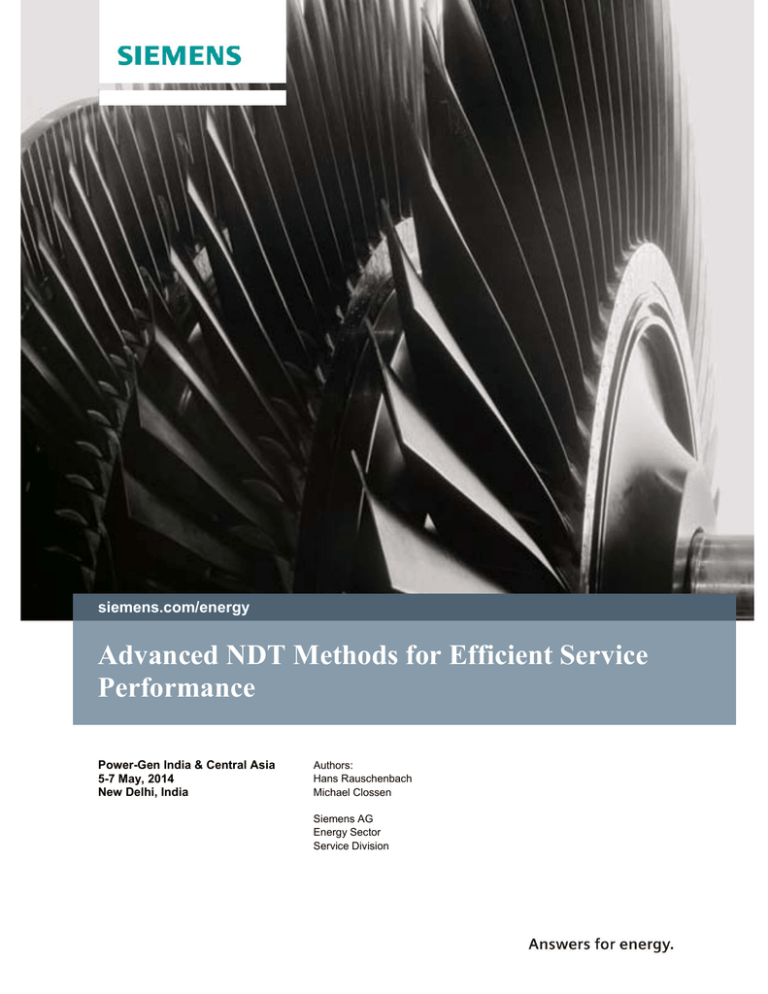
siemens.com/energy
Advanced NDT Methods for Efficient Service
Performance
Power-Gen India & Central Asia
5-7 May, 2014
New Delhi, India
Authors:
Hans Rauschenbach
Michael Clossen
Siemens AG
Energy Sector
Service Division
Table of Contents
1
Introduction ................................................................................................................. 3
2
Aspects of Non-Destructive Examination of Turbine and Generator Components.... 3
2.1
Inspection of Steam Turbine Blades ........................................................................... 4
2.2
Requalification of Turbine Rotors .............................................................................. 6
3
In-service Inspection of Generator Retaining Rings ................................................... 8
3.1
Experience with Different Inspection Techniques ...................................................... 9
3.2
Requirement for a new Inspection Technique ............................................................ 9
4
Conclusion ................................................................................................................ 11
5
References ................................................................................................................. 12
6
Disclaimer ................................................................................................................. 13
AL: N; ECCN: N
Unrestricted © Siemens AG 2014. All rights reserved.
Page 2 of 14
1 Introduction
International competition in the field of power generation is increasing, and customers are
demanding economic and efficient power plants. In the long term, continuous power plant
availability can only be guaranteed through an effective mode of operation in conjunction
with a systematic maintenance and inspection concept. The most highly stressed components
in a power plant include apart from the boiler, steam piping and valves, also the rotating
components of the turbine/generator (turbine and generator rotor). Loads, for example, result
from operating parameters, the mode of operation of the machinery, startup processes,
thermal stresses, pre-stressing, residual stresses from the manufacturing process, as well as
loading from the centrifugal forces acting on the rotating components. During scheduled
outages, highly-stressed components are subjected to non-destructive testing designed to
reliably detect any possible service-induced damage (e.g. cracking) before this can lead to
failure of a component and severe consequential damage. Quite apart from the risk to personal
health, damage to turbine or generator components can lead to unscheduled outages and plant
downtime, as well as unplanned costs for expensive repair and maintenance work on the
turbine/generator. In comparison to these risks, the cost of inspecting such highly-stressed
components is easily justified, as is the need for reliable and qualified techniques in the field
of non-destructive testing.
Siemens Energy has developed an inspection concept for steam and gas turbine generator
units which provides for scheduled inspections depending on the configuration, mode of
operation and the number of hours of operation of the turbine generator unit. This makes use
of special, validated non-destructive testing techniques. These testing techniques have been
developed to allow particularly highly-stressed components in the turbine generator unit to be
tested reliably while keeping disassembly to a necessary minimum.
2 Aspects of Non-Destructive Examination of Turbine and
Generator Components
Non-destructive testing is a very important aid to assuring the safety and availability of steam
and gas turbines. That is why non-destructive examinations are a standard feature in schedules
for turbine and generator maintenance inspections and overhauls.
AL: N; ECCN: N
Unrestricted © Siemens AG 2014. All rights reserved.
Page 3 of 14
To be able to perform non-destructive testing in the context of servicing turbines and
generators, numerous technical, organizational and personnel qualification requirements need
to be fulfilled to ensure high-quality testing performance and proper analysis and
documentation of test results. EN ISO 17025/2005 is internationally recognized as the stateof-the-art standard for defining quality criteria in the context of non-destructive testing.
While there are a number of commonly used non-destructive examination techniques such as
visual inspection (VT), magnetic particle testing (MT), liquid penetrant testing (PT),
ultrasonic testing (UT), radiographic testing (RT) and eddy current testing (ET)), modern,
component-specific techniques, such as phased-array applications, and mechanized UT or ET
testing may also be used. Testing is performed in accordance with test procedures which must
be approved and released by a suitably qualified test supervisor. The persons actually
performing the tests must meet certain minimum requirements in order to cope with the
specific demands made by the individual techniques.
As a global turbine manufacturer Siemens Energy Service Division offers turbine generator
services on a worldwide scale. This involves a team of qualified testing specialists also
working on worldwide basis. The Siemens Service organizational units in Germany, the UK
and the USA work in close cooperation providing a regular exchange of
inspection
information and expertise between both sides of the Atlantic. This is particularly important in
respect of evaluating fleet experience and drawing conclusions regarding the testing
techniques to be used.
2.1
Inspection of Steam Turbine Blades
The blades and blade attachments in a steam turbine belong to the most-highly stressed
components in a turbine/generator. The high turbine speed (3000 rpm) and the dead weight of
the blades mean that the blades of the final stage in a steam turbine are subjected to enormous
centrifugal forces during plant operation. The roots on such blades are designed and
calculated using the most up-to-date methods to allow them to accommodate these high loads.
During transient loading conditions (startup and shutdown processes) in particular, certain
areas of the blade roots and blade attachment grooves are subjected to high stressing.
Under unfavorable conditions unusual events occurring during operation of a turbine (e.g. loss
of vacuum, overspeed) can result in damage to blading, with possible crack initiation in the
highly-stressed areas of the blade root and subsequent service-induced crack propagation. In
AL: N; ECCN: N
Unrestricted © Siemens AG 2014. All rights reserved.
Page 4 of 14
addition, steam purity is also an important criterion regarding the susceptibility of a turbine
blade to corrosion. If the steam is polluted with chlorides this is a basic cause of corrosion
fatigue in turbine blades, blade roots and blade attachment areas. In the light of such
influences on safe turbine blade operation, the necessity for non-destructive testing becomes
particularly apparent. Turbine blades and their roots should be examined non-destructively at
predetermined intervals to allow timely detection of any damage and the replacement of
affected blades.
The task faced here was to develop an ultrasonic testing technique for special types of blade
roots to allow inspection of the most stressed blade roots in the rotor of a low-pressure steam
turbine. When installed in the rotor the most highly-stressed areas of the blade root are not
accessible for standard crack testing techniques. The objective was therefore to develop a
technique which allowed these highly-stressed areas of the blade root to be inspected in situ,
i.e. without opening the turbine. The examination system had to provide reliable and
reproducible results while remaining cost effective.
Extensive theoretical investigations had to be performed before any decisions could be made
regarding selection of the ultrasonic examination technique. Reference reflectors were
introduced into the calibration blocks at the most-highly-stressed areas. These areas were
defined by Siemens Engineering. Using identical blades for the development of the UT
inspection technique revealed information about detectability across all serrations of the blade
roots to be inspected.
Fig. 1: Phased array UT inspection of turbine blade roots
Once the investigations on the calibration block had confirmed the suitability of the selected
inspection technique for the problem in hand, a contoured probe and a tailor-made encoder-
AL: N; ECCN: N
Unrestricted © Siemens AG 2014. All rights reserved.
Page 5 of 14
driven hand scanner were fabricated. The probe holders were matched to the blade root
contour to guarantee exact positioning of the ultrasonic search units. Their use in conjunction
with a Phased Array UT device (Omniscan) guarantees an effective inspection.
Meanwhile phased array blade root inspection of more than 300 turbine
rotors were
performed by Siemens Energy worlwide. Building on these experiences, the inspection
technique was further improved. Phased array inspection of blade roots, as performed by
Siemens Energy, represents the state-of-the-art technology in advanced non-destructive
examination methods.
2.2 Requalification of Turbine Rotors
2.2.1 Description of Background
Turbine and generator shafts are highly-stressed components of turbine-generator sets
1, 2, 3 . In spite of good experiences overall, a few cases of failure of shafts due to ruptures
or bursts have occurred, which have affected all manufacturers. All failure mechanisms are
known today, so damage of this type can now be prevented with suitable countermeasures.
Ultrasonic examinations on rotating forged parts are aimed at reliably detecting, sizing and
pin-pointing manufacturing-induced flaws which may be relevant to the operational safety
and reliability of turbine and generator shafts. Acceptance tests of forged turbine-generator set
parts have formed part of the quality management system of turbine and generator
manufacturers for many years.
Experience of ultrasonic examination of over 600 shafts was leveraged to enable development
of a technology which delivers further improvements in flaw detection, assessment of
indications and reproducibility thanks to the use of state-of-the-art computer-aided
techniques. The main objective is to detect and size tangentially extended (axially-oriented)
flaws in the core area, which measures about 50% of the outer diameter.
The complex surface geometry of rotors subjected to service-induced loading is restrictive
when recording all the details of the overall shaft volume, as compared to the rough contours
of new shafts. This complex geometry is due to the blading, sealing grooves and many other
such factors.
The gaps in the volumetric examination which occur as a result have to be covered as far as
possible by selecting axial scanning components. Examination of a shaft is performed in a
number of stages (paths). Each stage consists of a complete rotation of the shaft and the
associated scanning to record data from 0 through 360. The scanning density around the
AL: N; ECCN: N
Unrestricted © Siemens AG 2014. All rights reserved.
Page 6 of 14
circumference of the shaft, i.e. the number of "shots", is determined on the basis of the search
unit sound field (6 dB sensitivity range) and the examination area (core area, boundary area,
etc.). The axial spacing of the scanning paths and the axial scanning component itself are
selected so as to ensure overlap of the 6 dB sensitivity range of the sound field in the
examination area. The phased array UT technology supports efficient UT volumetric
inspection of fully bladed turbine rotors.
Fig. 2: UT inspection of a fully bladed LP turbine rotor in the power plant
2.2.2 New Technology for UT Rotor Requalification
When inspecting the volume of turbine shafts, the required test sensitivity can only be
achieved by removing numerous seal strips. This is to allow proper coupling of the ultrasonic
probe to the examination surface of the turbine shaft via a couplant when using UT contact
techniques. Test sensitivity is compromised when testing across seal strip grooves and this
must be considered when setting the sensitivity of the examination system. The removal of
seal strips for UT volume testing and their replacement after testing represent one of the
major cost factors. Where testing requires that seal strips over between 200 and 300 m have to
be replaced, this can result in considerable costs.
In order to save on such costs, the Siemens Energy NDT laboratory in Mülheim in Germany
developed a testing technique which allows ultrasonic testing of fully-bladed turbine rotors,
without having to remove seal strips between the blades or in the area of the shaft glands.
Comprehensive investigations were performed on a bladed HP turbine shaft complete with
seal strips to provide realistic conditions. Using the phased-array UT technique it was possible
to develop a testing technique which allows the ultrasonic beam to be introduced over
installed seal strips without suffering significant losses in test sensitivity. This was confirmed
AL: N; ECCN: N
Unrestricted © Siemens AG 2014. All rights reserved.
Page 7 of 14
in comprehensive tests. The technique developed has made it possible to significantly reduce
the costs of UT requalifications while maintaining the quality of testing.
The newly-developed UT technique for requalification of turbine shafts was used successfully
for the first time in December 2013 on 2 turbine shafts in the Siemens workshop in Essen.
Further contracts have already been received for a large-scale turbine overhaul in Africa
scheduled for April 2014.
Fig. 3: UT Phased Array Inspection of a HP Turbine Rotor with installed seal strips in the
Siemens Workshop in Essen / Germany
3 In-service Inspection of Generator Retaining Rings
Rotor retaining rings are the components of turbine generators that are subjected to the
highest stress. SIEMENS Energy Service Division has many years of experience in
performing ultrasonic examinations on shrink-fitted rotor retaining rings in measures aimed at
preventing retaining ring damage due to stress-corrosion cracking (VDEW – AA publication,
1993). Before the mid-80's, generator rotor retaining rings were manufactured in the material
18Mn5Cr. Field service degradation of 18Mn5Cr material has resulted in stress corrosion
cracking (SCC) being the predominant failure mechanism. In view of this, periodic in-service
inspection of rings or replacement of rings with stress corrosion resistant material made of
18Mn18Cr material was recommended by the OEMs. By the mid-90's most 18Mn5Cr rings had
been replaced with 18Mn18Cr rings.
AL: N; ECCN: N
Unrestricted © Siemens AG 2014. All rights reserved.
Page 8 of 14
3.1
Experience with Different Inspection Techniques
SIEMENS Energy, Service Division carries out ultrasonic examinations on rotor retaining
rings in the shrunk-on condition. This ensures that the shrinkage stresses are maintained in the
component, and enables reliable detection of any incipient cracks in the shrink fit.
The so-called “corner reflection” search technique is used, whereby the shrink fit is scanned
such that the ultrasound impinges on the inside surface of the rotor retaining ring at an angle
of approximately 45°. This search technique enables reliable detection of any incipient cracks
in the shrink fit.
Experience has shown that this inspection technique enables reliable detection of the smallest
material flaws. The corner reflection technique allows both circumferential (cw and ccw) and
axial (GE and TE) scans to be performed, thereby ensuring reliable detection of indications
exhibiting all possible orientations.
Experience gained by SIEMENS Energy Service
Division shows that scanning from a number of directions is a prerequisite for detection of
extremely small material flaws in the shrink fit. If indications are found during an inspection
using this search technique, further analytical techniques are available to determine the extent
of the indications (determination of crack depth/indication length).
3.2
Requirement for a new Inspection Technique
Since 1996, a mechanized system has been available for inspection of rotor retaining rings.
This system offers the following advantages in comparison with manual ultrasonic
examination:
-
Full data recording capability enables data archiving and comparison of test results
with in-service inspections.
-
Inspection reliability is significantly increased in comparison with manual techniques,
as mechanized performance largely excludes subjective influences which could
potentially influence the inspection result.
-
In the case of geometric indications in the shrink fit (due to slot wedges and rotor
teeth), mechanized ultrasonic examination exclusively offers the possibility of clearly
distinguishing between geometric indications and actual crack indications.
-
Mechanized ultrasonic examination enjoys a good level of acceptance with
independent inspection agencies and insurers, as the technique enables all data
AL: N; ECCN: N
Unrestricted © Siemens AG 2014. All rights reserved.
Page 9 of 14
relevant to the inspection to be recorded and utilized for subsequent analysis at any
time.
However, while the 18Mn-18Cr alloy has not exhibited a longer term fracture mode, there
have been some unique cases where cracking in service has been observed. In these cases,
cracking has occurred under conditions outside normal design limits.
The power generation industry is moving towards longer intervals between “rotor out”
maintenance outages, so the inspection of retaining rings should be performed after 10…12
years or more.
To ensure the reliable operation of generator rotors, advanced non-destructive examination
techniques for the inspection of retaining rings are required. Siemens Energy has developed a
state-of-the-art, combined, automated UT, ET & VT Inspection system, which supports insitu inspection (rotor in place) as well as inspection when the rotor is out of the stator. This
inspection system was developed in close co-operation between the NDT teams of Siemens
Energy located in US, UK and Germany. It was based on the qualification of a combined UT
and ET inspection technique for a real retaining ring. According to the instructions of
Siemens Generator Engineering, several artificial flaws were made in all critical areas of the
real retaining ring. After manufacturing of a mandril (disk with geometrical features of the
generator rotor to simulate the influence of the rotor teeth on the UT result) the mandril was
shrunk in the retaining ring. So an extensive qualification process of the UT technique was
performed. All artificial flaws were detected. The trials were performed by NDT experts from
Siemens Pittsburgh; Siemens Newcastle (UK) as well as Siemens Mülheim. In result of the
qualification process an advanced UT, ET and VT inspection system was developed, which
already is in use in Generator Service. The in-situ inspection reduces outage time, because
there is no longer any need to remove the rotor from stator for the inspection.
Fig. 4: In-situ retaining ring inspection
AL: N; ECCN: N
Unrestricted © Siemens AG 2014. All rights reserved.
Page 10 of 14
4 Conclusion
These three examples of advanced inspection techniques demonstrate that direct customer
benefits can be delivered through the use of problem-focused techniques. Key examples
include time savings for component disassembly and reassembly required with conventional
crack inspection techniques, but eliminated when advanced techniques are used. Given the
requirement for virtually non-stop power plant availability and the associated reduction in
plant downtimes, these kinds of in-situ service techniques are playing an increasingly
important role in the planning and execution of plant outages.
AL: N; ECCN: N
Unrestricted © Siemens AG 2014. All rights reserved.
Page 11 of 14
5 References
[1] H. Rauschenbach / Dr. M. Opheys / U. Mann / J. Achtzehn (8th European Conference on
Non-Destructive Testing Barcelona June 17 – 21, 2002 ):
Advanced NDE Inspection Methods for Field Service at Power Plants; Conference
[2] H. Rauschenbach / M. Siegel / B. Metzner / (VGB-ESKOM International Materials
Conference, Pretoria, South Africa, 2000)
Nondestructive Examination of Turbine and Generator Components, Experience with
Mechanized Examination Techniques ; Conference
[3] M. Clossen / M. Opheys / H. Rauschenbach / M. Siegel (9th EPRI Steam Turbine &
Generator Workshop Denver , Colorado ; USA ; 2005)
Advanced NDE Inspection Methods for detection of SCC in Blade Attachments and
Blade Roots ; Conference
[4] VDEW Recommendation to avoid Stress Corrosion Induced Rotor Retaining Ring
Cracking (1993): Verband der Elektrizitätswirtschaft e. V. (VDEW), Technical
Recommendation
[5] C. Ward /K. Stamps (Insight Vol. 48 No 9 Sept. 2006)
Options for management of retaining ring inspection): technical magazine
AL: N; ECCN: N
Unrestricted © Siemens AG 2014. All rights reserved.
Page 12 of 14
6 Disclaimer
These documents contain forward-looking statements and information – that is, statements
related to future, not past, events. These statements may be identified either orally or in
writing by words as “expects”, “anticipates”, “intends”, “plans”, “believes”, “seeks”,
“estimates”, “will” or words of similar meaning. Such statements are based on our current
expectations and certain assumptions, and are, therefore, subject to certain risks and
uncertainties. A variety of factors, many of which are beyond Siemens’ control, affect its
operations, performance, business strategy and results and could cause the actual results,
performance or achievements of Siemens worldwide to be materially different from any
future results, performance or achievements that may be expressed or implied by such
forward-looking statements. For us, particular uncertainties arise, among others, from changes
in general economic and business conditions, changes in currency exchange rates and interest
rates, introduction of competing products or technologies by other companies, lack of
acceptance of new products or services by customers targeted by Siemens worldwide,
changes in business strategy and various other factors. More detailed information about
certain of these factors is contained in Siemens’ filings with the SEC, which are available on
the Siemens website, www.siemens.com and on the SEC’s website, www.sec.gov. Should one
or more of these risks or uncertainties materialize, or should underlying assumptions prove
incorrect, actual results may vary materially from those described in the relevant forwardlooking statement as anticipated, believed, estimated, expected, intended, planned or
projected. Siemens does not intend or assume any obligation to update or revise these
forward-looking statements in light of developments which differ from those anticipated.
Trademarks mentioned in these documents are the property of Siemens AG, its affiliates or
their respective owners.
AL: N; ECCN: N
Unrestricted © Siemens AG 2014. All rights reserved.
Page 13 of 14
Published by and copyright © 2014:
Siemens AG
Energy Sector
Freyeslebenstrasse 1
91058 Erlangen, Germany
Siemens Energy, Inc.
4400 Alafaya Trail
Orlando, FL 32826-2399, USA
For more information, please contact
our Customer Support Center.
Phone: +49 180/524 70 00
Fax:
+49 180/524 24 71
(Charges depending on provider)
E-mail: support.energy@siemens.com
All rights reserved.
Trademarks mentioned in this document are
the property of Siemens AG, its affiliates,
or their respective owners.
AL: N; ECCN: N
Subject to change without prior notice.
The information in this document contains
general descriptions of the technical options
available, which may not apply in all cases.
The required technical options should therefore
be specified in the contract..
Unrestricted © Siemens AG 2014. All rights reserved.
Page 14 of 14

